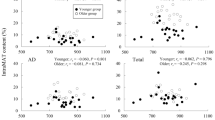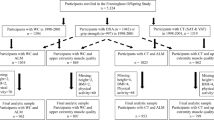Abstract
Purpose
Skeletal muscles of older individuals have a larger amount of intramuscular adipose tissue (IntraMAT) than those of younger individuals. It is not understood how aging affects the IntraMAT content of individual muscles of the thigh. We assessed the relationship between IntraMAT content and skeletal muscle cross-sectional area (CSA), subcutaneous adipose tissue CSA, biochemical blood profiles, and physical activity.
Methods
Fifteen older (70.7 ± 3.8 years) and 15 younger (20.9 ± 0.3 years) men and women participated in this study. Magnetic resonance imaging of the right thigh was taken to measure IntraMAT content and skeletal muscle CSA for the quadriceps femoris (QF), hamstrings (HM), adductor (AD) muscle groups and subcutaneous adipose tissue CSA of the thigh. Fasting blood samples were collected to measure plasma lipids, adiponectin, and HbA1c levels.
Results
IntraMAT content in QF, HM, and AD for the Older group was significantly higher than in the Younger group. However, skeletal muscle CSA normalized by body weight (skeletal muscle CSA/bw) in the QF (P < 0.001) and total thigh (P < 0.01) were significantly lower in the Older group compared with the Younger group.There were no significant differences in HM and AD. Stepwise regression analysis with IntraMAT content as a dependent variable revealed that skeletal muscle CSA/bw of the thigh was the only predictive variable for IntraMAT content in Older and Younger groups.
Conclusion
These results suggest that skeletal muscle size could be a major determinant of IntraMAT content regardless of age.



Similar content being viewed by others
Abbreviations
- AD:
-
Hip adductor
- AL:
-
Adductor longus
- AM:
-
Adductor magnus
- ANOVA:
-
Analysis of variance
- BFl:
-
Biceps femoris-long head
- CSA:
-
Cross-sectional area
- FFA:
-
Free fatty acids
- Gr:
-
Gracilis
- HDL-C:
-
High-density lipoprotein-cholesterol
- HM:
-
Hamstrings
- IntraMAT:
-
Intramuscular adipose tissue
- LDL-C:
-
Low-density lipoprotein-cholesterol
- MRI:
-
Magnetic resonance imaging
- QF:
-
Quadriceps femoris
- RF:
-
Rectus femoris
- ROI:
-
Region-of-interest
- Sar:
-
Sartorius
- SM:
-
Semimembranosus
- ST:
-
Semitendinosus
- TG:
-
Triglycerides
- Total-C:
-
Total cholesterol
- VI:
-
Vastus intermedius
- VL:
-
Vastus lateralis
- VM:
-
Vastus medialis
References
Akima H, Kano Y, Enomoto Y, Ishizu M, Okada M, Oishi Y, Katsuta S, Kuno S (2001) Muscle function in 164 men and women aged 20–84 yrs. Med Sci Sports Exerc 33:220–226
Akima H, Lott D, Senesac C, Deol J, Gemain S, Arpan I, Bendixen R, Sweeney HL, Walter G, Vandenborne K (2012) Relationships of thigh muscle contractile and non-contractile tissue with function, strength, and age in boys with Duchenne muscular dystrophy. Neuromuscul Disord 22:16–25
Ayabe M, Kumahara H, Morimura K, Sakane N, Ishii K, Tanaka H (2013) Accumulation of short bouts of non-exercise daily physical activity is associated with lower visceral fat in Japanese female adults. Int J Sports Med 34:62–67
Boettcher M, Machann J, Stefan N, Thamer C, Haring H-U, Claussen CD, Fritsche A, Schick F (2009) Intermuscular adipose tissue (IMAT): association with other adipose tissue compartments and insulin sensitivity. J Magn Reson Imaging 29:1340–1345
Crane JD, Devries MC, Safdar A, Hamadeh MJ, Tarnopolsky MA (2010) The effect of aging on human skeletal muscle mitochondrial and intramyocellular lipid ultrastructure. J Gerontol A Bio Sci Med Sci 65A:119–128
DeNino WF, Ades PA, Tchernof A, Sites CK, Dionne IJ, Poehlman ET, Toth MJ (2001) Contribution of abdominal adiposity to age-related differences in insulin sensitivity and plasma lipids in healthy nonobese women. Diabetes Care 24:925–932
Fukunaga T, Miyatani M, Tachi M, Kouzaki M, Kawakami Y, Kanehisa H (2001) Muscle volume is a major determinant of joint torque in humans. Acta Physiol Scand 172:249–255
Gallagher D, Kuznia P, Heshka S, Aibu H, Heymsfield SB, Goodpaster B, Visse M, Harris TB (2005) Adipose tissue in muscle: a novel depot similar in size to visceral adipose tissue. Am J Clin Nutrit 81:903–910
Goodpaster BH, Thaete FL, Kelley DE (2000) Thigh adipose tissue distribution is associated with insulin resistance in obesity and in type 2 diabetes mellitus. Am J Clin Nutrit 71:885–892
Goodpaster BH, Krishnaswami S, Resnick DE, Haggerty C, Harris TB, Schwartz AV, Kritchevsky S, Newman AB (2003) Assoication between regional adipose tissue distribution and both type 2 diabetes and impaired glucose tolerance in elderly men and women. Diabetes Care 26:372–379
Janssen I, Fortier A, Hudson R, Ross RR (2002) Effects of an energy-restrictive diet with or without exercise on abdominal fat, intermuscular fat, and metabolic risk factors in obese women. Diabetes Care 25:431–438
Kent-Braun JA, Ng AV, Young H (2000) Skeletal muscle contractile and noncontractile components in young and older women and men. J Appl Physiol 88:662–668
Kumahara H, Schutz Y, Ayabe M, Yoshioka M, Yoshitake Y, Shindo M, Ishii K, Tanaka H (2004) The use of uniaxial accelerometer for the assessment of physical-activity-related energy expenditure: a validation study against whole-body indirect calorimetry. Br J Nutr 91:235–243
Lihn AS, Pedersen SB, Richelsen B (2005) Adiponectin: action, regulation and association to insulin sensitivity. Obes Rev 6:13–21
Manini TM, Clark BC, Goodpaster BH, Ploutz-Snyder LL, Harris TB (2007) Reduced physical activity increases intermuscular adipose tissue in health young adults. Am J Nutrit 85:377–384
Marcus RL, Addison O, Dibble LE, Foreman KB, Morrell G, LaStayo P (2012) Intramuscular adipose tissue, sarcopenia, and mobility function in older individuals. J Aging Res 2012:1–6
Maughan RJ, Watson JS, Weir J (1983) Strength and cross-sectional area of human skeletal muscle. J Physiol (London) 338:37–49
Overend TJ, Cunningham DA, Kramer JF, Lefcoe MS, Paterson DH (1992) Knee extensor and knee flexor stremgth:cross-sectional area ratios in young and elderly men. J Gerontol A Biol Sci Med Sci 47:M204–M210
Popadic Gacesa JZ, Dusko KB, Grujic NG (2011) Triceps brachii strength and regional body composition changes after detraining quantified by MRI. J Magn Reson Imaging 33:1114–1120
Ramsey JW, Barrance PJ, Buchanan TS, Higginson JS (2011) Paretic muscle atrophy and non-contractile tissue content in individual muscles of the post-stroke lower limb extremity. J Biomech 44:2741–2746
Rossi A, Zoico E, Goodpaster B, Sepe A, Di Francesco V, Fantin F, Pizzini F, Corzato F, Vitali A, Micciolo R, Harris TB, Cinti S, Zamboni M (2010) Quantification of intermuscular adipose tissue in the erector spinae muscle by MRI: agreement with histology evaluation. Obesity 18:2379–2384
Ryan AS, Nicklas BJ (1999) Age-related changes in fat deposition in mid-thigh muscle in women: relationships with metabolic cardiovascular disease risk factors. Int J Obes 23:126–132
Ryan AS, Nicklas BJ, Berman DM (2002) Racial differences in insulin resistance and mid-thigh fat deposition in postmenopausal women. Obes Res 10:336–344
Ryan AS, Buscemi A, Forrester L, Hafer-Macko CE, Ivey FM (2011) Atrophy and intramuscular fat in specific muscles of the thigh: associated weakness and hyperinsulinemia in stroke survivors. Neurorehabil Neural Repair 25:865–872
Schwenzer NF, Martirosian P, Machann J, Schraml C, Steidle G, Claussen CD, Schick F (2009) Aging effects on human calf muscle properties assessed by MRI at 3 tesla. J Magn Reson Imaging 29:1346–1354
Sezgin M, Sankur B (2004) Survey over image thresholding techniques and quantitative performance evaluation. J Electron Imaging 13:146–165
Sled JG, Zijdenbos AP (1998) A nonparametric method for automatic correction of intensity nonuniformity in MRI data. IEEE Trans Med Imaging 17:87–97
Song MY, Ruts E, Kim J, Janumala I, Heymsfield S, Gallagher D (2001) Sarcopenia and increased adipose tissue infiltration of muscle in elderly African American women. Am J Clin Nutrit 79:874–880
Taaffe DR, Henwood TR, Nalls MA, Walker DG, Lang TF, Harris TB (2009) Alterations in muscle attenuation following detraining and retraining in resistance-trained older adults. Gerontology 55:217–223
Tuttle LJ, Sinacore DR, Mueller MJ (2012) Intermuscular adipose tissue is muscle specific and associated with poor functional performance. J Aging Res 2012:1–7
Visser M, Kritchevsky SB, Goodpaster BH, Newman AB, Nevitt M, Stamm E, Harris TB (2002) Leg muscle mass and composition in relation to lower extremity performance in men and women aged 70–79: the health, aging and body composition study. J Am Geriatr Soc 50:897–904
Zoico E, Rossi A, Di Francesco V, Sepe A, Olioso D, Pizzini F, Fantin F, Bosello O, Cominacini L, Harris TB, Zamboni M (2010) Adipose tissue infiltration in skeletal muscle of healthy elderly men: relationships with body composition, insulin resistance, and inflammation at the systemic and tissue level. J Gerontol A Biol Sci Med Sci 65A:295–299
Acknowledgments
The authors gratefully thank the volunteers for participation as well as Drs Haruo Isoda and Atsushi Fukuyama and Radiologic technologist Mr. Akira Ishizuka, Graduate School of Medicine, Nagoya University. This study was supported in part by a Grant-in-Aid for challenging Exploratory Research from the Ministry of Education, Culture, Sports and Science and Technology Grant (#23650432) to HA.
Conflict of interest
The authors declare no conflict of interest.
Author information
Authors and Affiliations
Corresponding author
Additional information
Communicated by William J. Kraemer.
Rights and permissions
About this article
Cite this article
Akima, H., Yoshiko, A., Hioki, M. et al. Skeletal muscle size is a major predictor of intramuscular fat content regardless of age. Eur J Appl Physiol 115, 1627–1635 (2015). https://doi.org/10.1007/s00421-015-3148-2
Received:
Accepted:
Published:
Issue Date:
DOI: https://doi.org/10.1007/s00421-015-3148-2




